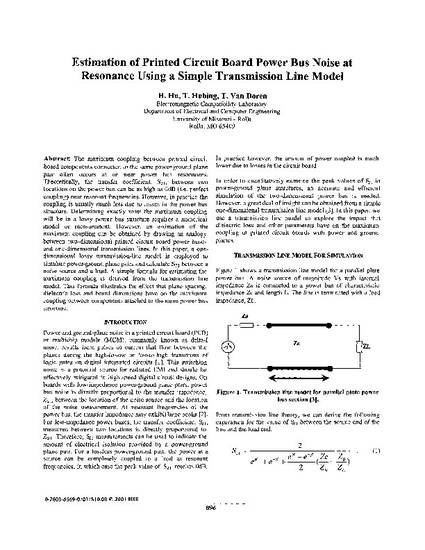
The maximum coupling between printed circuit board components connected to the same power-ground plane pair often occurs at or near power bus resonances. Theoretically, the transfer coefficient, S 21 , between two locations on the power bus can be as high as 0dB (i.e. perfect coupling) near resonant frequencies. However, in practice the coupling is usually much less due to losses in the power bus structure. Determining exactly what the maximum coupling will be in a lossy power bus structure requires a numerical model or measurement. However, an estimation of the maximum coupling can be obtained by drawing an analogy between two-dimensional printed circuit board power buses and one-dimensional transmission lines. In this paper, a one-dimensional lossy transmission-line model is employed to simulate power-ground plane pairs and calculate S 21 between a noise source and a load. A simple formula for estimating the maximum coupling is derived from the transmission line model. This formula illustrates the effect that plane spacing, dielectric loss and board dimensions have on the maximum coupling between components attached to the same power bus structure
- Absorbing Media,
- Board Dimensions,
- Dielectric Loss,
- Dielectric Losses,
- Electromagnetic Coupling,
- Electromagnetic Interference,
- Losses,
- Lossy Power Bus Structure,
- Maximum Coupling,
- Noise Source,
- Numerical Model,
- One-Dimensional Transmission Lines,
- Perfect Coupling,
- Plane Spacing,
- Power-Ground Plane Pairs,
- Printed Circuit Board Power Bus Noise,
- Printed Circuits,
- Resonance,
- Simple Transmission Line Model,
- Transfer Coefficient,
- Transmission Line Model,
- Transmission Line Theory,
- Two-Dimensional Printed Circuit Board Power Buses
Available at: http://works.bepress.com/thomas-vandoren/54/